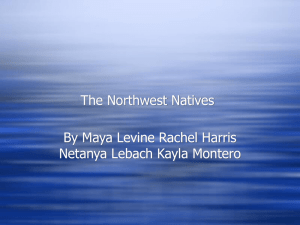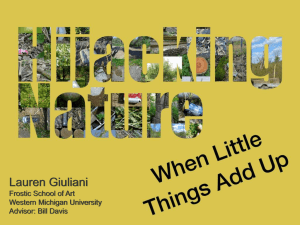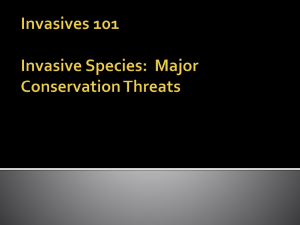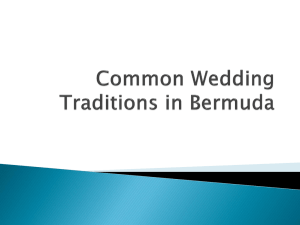cedar policy 0513 - Department of Agricultural Economics
advertisement
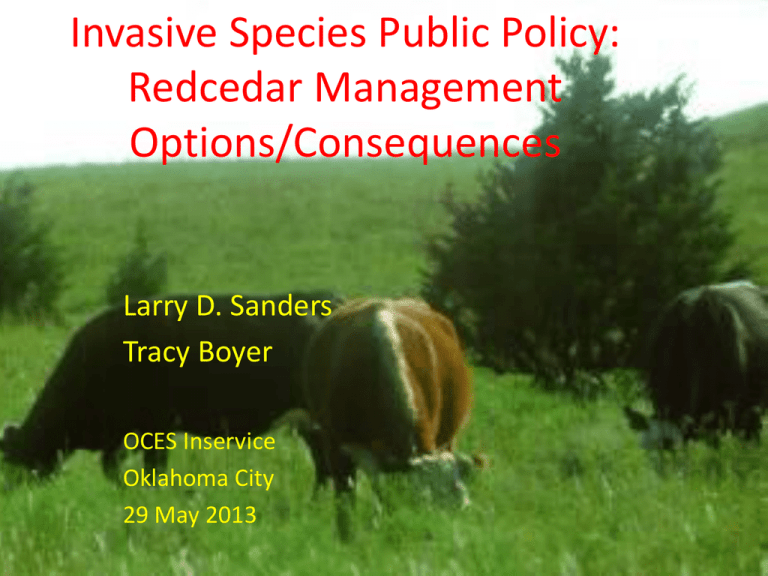
Invasive Species Public Policy: Redcedar Management Options/Consequences Larry D. Sanders Tracy Boyer OCES Inservice Oklahoma City 29 May 2013 1 Eastern Redcedar: An opportunity or a Curse? • Curse argument: – A “weed” to eradicate • Opportunity argument: – Value-added potential •The political problem •Private property rights •Compensation 2 Redcedar management options (state or private funding?) Graze-out w/Goats (cost Uncertain; Unintended Harm?) Natural burn (Wildfire; Proliferation issues) Managed burn (relatively low cost; maintenance cost) Cut/remove (costly; Maintenance cost) Other options? Chemical application (cost uncertain; environmental harm uncertain) Value-added crop (infrastructure cost; market uncertain; inconsistent stocks; cedar proliferation issues) 3 Renewable energy Logs for heating Process for bio-fuel (state/feds may support) Natural Pesticides Few examples of private profitability; public subsidy likely Aromatic oils Shredded animal bedding; Mulch Redcedar “potential” benefits Existence of Value-added acreage assures Infestation of other acreage Construction material Furniture Windbreaks/ landscape aesthetics Habitat/hunting --trade-off one habitat for another Compensation 4 Land opportunity cost Health Concerns Habitat Compensation Potential cost of redcedar existence Spread to other land Cost to manage Wildfire danger 5 Redcedar state policy • The Eastern Redcedar Registry Board consists of 12 members as outlined by the Eastern Redcedar Registry Board Act (HB2686 2010). • Links interested land owners w/markets – Landowners directory—about 250 – Harvesters directory—11 – Producers directory--18 • Current members: • • • • • • Gary Bledsoe Bruce Brown Elmer Maddux Paul Todd Charles Battles Salim Hiziroglu Vacant Jim Reese Mike Thralls Steve Thompson Bob Thompson Steve Glasgow Chair Vice Chair Board Member Board Member Board Member Board Member Board Member Board Member Board Member Board Member Board Member Board Member Governor Appointee Governor Appointee Speaker of House Appointee Governor Appointee Speaker of House Appointee Senate President Pro Tempore Appointee Senate President Pro Tempore Appointee Secretary of Agriculture Executive Director, Conservation Commission Executive Director, Department of Environmental Quality Executive Director, Corporation Commission USDA - NRCS (Designee) • http://www.forestry.ok.gov/ercregistry 6 2011: HB1486 Woody Biomass Energy Initiative; Fallin vetoed Attempts at state legislation 2012: SB1539 Use of state prisoners amended by Morrisette to use for cedar removal on public lands; Fallin signed May 2012 HB2695 OK Resource Reclamation Act; Redcedar removal, esp. “abandoned” land Failed in committee 2013: HB1656 Re-attempt at Woody Biomass bill HB 1513 Inmate certification for harvest/eradication skills HB1515 Re-attempt at OK Resource Reclamation Act7 Legislative update • Morrissette ‘s 3 cedar bills passed through all committees; later stalled in Senate or on procedural grounds. • HB1513, to allow inmate labor to harvest cedar (in statute as a result of a Morrissette amendment to SB1513-2012) & for inmates to receive Career Tech certification post incarceration in cutting/harvesting, framing/carpentry and livestock management. • HB1515, several aspects to include revaluation of lands infested with cedar when tax assessment categorization falls to “TIMBER WASTE” • HB1656 Woody Biomass Energy Initiative: establish commission to direct the development of biofuel from cedar biomass. • The bills can be viewed in their entirety on line www.okhouse.gov 8 Options to manage redcedar STATUS QUO -limited education/ research -private choice -unlikely eradication - STATE ASSISTED VOLUNTARY CONTROL -Education/research/state aid -slow reduction, if any STATE-ASSISTED MANDATORY CONTROL -Education/research/state aid -Fines/penalties -Assume major reduction NO PUBLIC AID MANDATORY CONTROL -Education/research low -Fines/penalties -Assume major reduction Options to manage redcedar & their likely consequences… STATUS QUO -Benefits: Landowner choice Cedar-based habitat Value-added potential -Costs: Wildfire risk Owner cost hi Allergens Uncertainty STATE ASSISTED VOLUNTARY CONTROL -Benefits: Cut fire risk/allergens; Gain some water/land Limit state cost; Some state aid Costs: State cost up; Owner expense limited Cedar habitat loss; Uncertainty STATE-ASSISTED MANDATORY CONTROL Benefits: Major cut in cedar threat/allergens/ fire danger; Gain water/land Costs: Lose owner choice/Cedar habitat; State cost limited; Owner cost hi; may limit valueadded NO PUBLIC AID MANDATORY CONTROL Benefits: State cost low; Major cut in cedar threat/allergens/ fire danger; Gain water/land Costs: Lose owner choice/Cedar habitat; owner cost hi; may limit value-added Percentage Cropland Acres Changed – 1992 to 2007 453 Lincoln 609 422 Creek Payne 560 Rogers % of change -91.3 - -30.6 -30.5 - -20.6 -20.5 - -11.6 -11.5 - -0.9 1.0400+: - 18 Indicates counties with change in number of farms with 100 or fewer acres, 1992-2007 426 Ok. 436 McC.458 Clev 454 428 414 11 McCur. Key Questions in Formulating/Implementing Redcedar Management Policy 1. 2. 3. 4. 5. 6. 7. 8. 9. 10. 11. Define success: Eradication? Reduction? Public/private land? Exempt residences in city limits, and/or by size of acreage? State license/supervision required for event? Which methods acceptable/required: burn, chemical, cut? (who pays?) Re-infestation “insurance” for cooperators? (Regulatory “certainty”) Cost exposure to state? (limit outlay, per owner/acre, liability)? Nature of state assistance? ( funds, contract, public manpower) Time frame for “successful level” of reduction? Will state aid be on sliding scale dependent on specified owner qualifications? If state provides financial aid, which funding vehicles: lo/no interest loans, tax breaks, cash, in-kind, other? 12 What to do about private property rights? Research Needs • Update field research on encroachment and management strategies, including basic growth rates • Threshold levels/triggers for cedar management outpacing regeneration rates • Assessment of “success” for private and public lands • Habitat issues • Wildfire impact on insurance • Benefit-Cost analysis for public investment & private management options • Climate impacts on cedar • Owner response to state incentives/disincentives • Economic options for value-added production of cedar 13 Cedar expertise at OSU • • • • • • • • • • • • Terry Bidwell, Rangeland Ecology & Management Dave Engle, Range Management Don Turton, Forest & Rangeland Hydrology Chris Zou, Ecohydrology Rod Will, Silviculture Karen Hickman, Rangeland Ecology & Management Sam Fuhlendorf, Rangeland Ecology & Management Salim Hiziroglu, Wood Products Craig McKinley, Extension Forestry Derrell Peel, Livestock Economics Tracy Boyer, Environmental Economics Larry Sanders, Policy Economics 14 Other sources of information • • • • • • Oklahoma Cooperative Extension Service Eastern Red Cedar Registry Board Aromatic Cedar Association Oklahoma Department of Commerce Oklahoma Department of Agriculture, Food & Forestry Oklahoma Department of Corrections • • • • • Oklahoma Conservation Commission Oklahoma Association of Conservation Districts Economic Development, Business & Industry Services, Career Tech ARS, NRCS, other USDA State Sen. Ron Justice & State Rep. Richard 15 Morrissette Contact info for assistance… • larry.sanders@okstate.edu • 405-744-9834 • tracy.boyer@okstate.edu • 405-744-6169 http://kfor.com/2013/03/05/commissionerannounces-plan-to-remove-red-cedars/ 16
